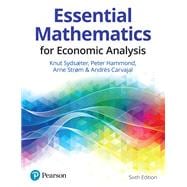Acquire the key mathematical skills you need to master and succeed in Economics.
Essential Mathematics for Economic Analysis, 6th edition by Sydsaeter, Hammond, Strøm, and Carvajal is a global best-selling text providing an extensive introduction to all the mathematical resources you need to study economics at an intermediate level.
This book has been applauded for covering a broad range of mathematical knowledge, techniques, and tools, progressing from elementary calculus to more advanced topics.
With a plethora of practice examples, questions, and solutions integrated throughout, this latest edition provides you a wealth of opportunities to apply them in specific economic situations, helping you develop key mathematical skills as your course progresses.
Key features:
- Numerous exercisesand worked examples throughout each chapter allow you to practice skills and improve techniques.
- Review exercisesat the end of each chapter test your understanding of a topic, allowing you to progress with confidence.
- Solutionsto exercises are provided in the book and online, showing you the steps needed to arrive at the correct answer.
Pair this text with MyLab® Math
MyLab® is the teaching and learning platform that empowers you to reach every student. By combining trusted author content with digital tools and a flexible platform, MyMathLab personalises the learning experience and improves results for each student.
If you would like to purchase both the physical text and MyMathLab, search for:
9781292359342 Essential Mathematics for Economic Analysis, 6th edition with MyMathLab
Package consists of:
- 9781292359281 Essential Mathematics for Economic Analysis, 6th edition
- 9781292359311 Essential Mathematics for Economic Analysis, 6th edition MyMathLab
- 9781292359335 Essential Mathematics for Economic Analysis, 6th edition Pearson eText
MyLab® Math is not included. Students, if MyLab is a recommended/mandatory component of the course, please ask your instructor for the correct ISBN. MyLab should only be purchased when required by an instructor. Instructors, contact your Pearson representative for more information.








